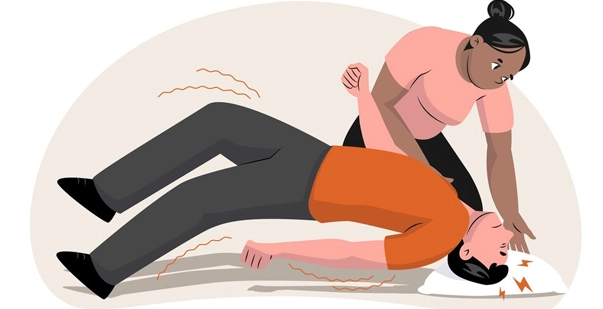Epilepsy is a condition that affects the brain and causes recurring seizures. It’s quite common globally, and in the United States, it’s considered the fourth most prevalent neurological disorder. Over 65 million people worldwide live with epilepsy. In 2021, about 1.1% of adults in the US—around 2.865 million individuals—reported having active epilepsy, while another 0.6% said they had inactive epilepsy.
Seizures are the main sign of epilepsy. They happen because the brain’s electrical activity becomes abnormal. Seizures can show up in different ways, like sudden jerking or short moments of not being aware. It’s important for everyone to understand epilepsy, not just those who have it but also their families, caregivers, and everyone around them.
Even though epilepsy is common, many people don’t really understand it, which can lead to wrong ideas and unfair treatment.
This article explores the basics of epilepsy: what causes it, its symptoms, how doctors diagnose it, and the treatments available. We want to help people understand epilepsy better so they can manage it well. Let’s start by knowing what is a epileptic seizure?
What is Epileptic Seizure?
A sudden transient episode of abnormal electrical activity in the brain is called an epileptic seizure. This temporary disruption of normal brain function by such an abnormal activity can cause various symptoms ranging from mild to severe.
Depending on the location of the affected area in the brain and type of epilepsy, seizures may present differently in different people.
During a seizure, a person may experience:
- Motor Symptoms
- Sensory Symptoms
- Autonomic Symptoms
- Psychological Symptoms
Seizures can be short or long, and their strength can vary. After a seizure, people might feel confused, tired, or have trouble speaking or moving for a short time called the postictal phase.
Epileptic seizures happen more than once and can be treated with medicines, changes in lifestyle, or surgery, depending on how serious they are. It’s important to understand epilepsy and its seizures to diagnose it correctly, treat it effectively, and help people with the condition live better lives.
Types of Epileptic Seizures
There are two main types of epileptic seizures: generalized and focal seizures. These types describe where the seizure starts in the brain and how it may affect a person.
1. Generalized Seizures
The age-adjusted incidence of epilepsy, which involves recurrent unprovoked seizures, varies between 24 to 53 cases per 100,000 people annually. About 20-25% of these cases are categorized as generalized seizures, affecting the entire brain from the start.
Generalized Seizures affect the whole brain from the start, leading to various types:
- Tonic-Clonic Seizures (Grand Mal) cause sudden unconsciousness and stiff muscles, followed by rhythmic jerking. Breathing might become irregular, and falling can cause injury.
- Absence Seizures (Petit Mal) are common in children, causing brief lapses in awareness where they may stare blankly. These seizures last only a few seconds and the person quickly returns to normal.
- Myoclonic Seizures result in sudden, quick jerks of muscles, often in clusters.
- Atonic Seizures (Drop Attacks) cause sudden loss of muscle control, leading to falls or collapsing.
Each type of seizure requires specific care and understanding to manage effectively.
2. Focal (Partial) Seizures
Focal seizures are the most common type of seizure, accounting for more than half of all seizures. The median incidence rate is 30.4 per 100,000 people per year, which is higher than the 19.6 per 100,000 per year rate for generalized seizures.
Focal seizures are more common in people under 60, with an incidence of 20 per 100,000 person-years, and in people aged 60–80, with an incidence of 80 per 100,000 person-years.
Focal seizures can be categorized into different types, including focal impaired awareness seizures and simple partial seizures:
- Focal impaired awareness seizures: These seizures are the most common type of seizure in people with epilepsy after the first year of life, affecting about 36% of people with the condition. They can affect people of all ages, but are most common in children and older adults.
- Simple partial seizures: These seizures affect about 15% of people with seizures. Symptoms can include motor, cognitive, sensory, autonomic, or affective issues, but consciousness is not impaired. Common symptoms include sudden feelings of fear, anger, sadness, happiness, or nausea, sensations of falling or movement, and altered senses.
Causes of Epileptic Seizures
Epileptic seizures are caused by scrambled electrical signals in the brain that can sometimes lead to sudden bursts of electrical activity. The causes of epilepsy can be categorized as structural, genetic, infectious, metabolic, immune, or unknown. Understanding epileptic seizure causes is crucial for managing and treating epilepsy effectively. Some possible causes include:
1. Neurological Conditions
Brain injuries from accidents or strokes can change how brain cells communicate, causing seizures. These injuries disturb the brain’s usual electrical activity, making it more likely to send out sudden bursts of abnormal signals.
Tumors in the brain can also cause seizures by pressing on or invading nearby tissues. Conditions like Alzheimer’s disease, multiple sclerosis, and developmental disorders can affect how the brain works, making seizures more likely.
Knowing about these brain-related issues helps doctors diagnose epilepsy and create treatments that can control or lessen how often seizures happen.
2. Genetic Factors
Some types of epilepsy are linked to genetics, meaning they can run in families. This happens when specific gene changes or inherited traits increase the chances of having seizures. If someone in a family has epilepsy, there’s a greater likelihood that other family members could also develop it.
Researchers study these genetic connections to understand how epilepsy passes through generations. Knowing the genetic factors helps doctors diagnose epilepsy and choose the best treatments.
It also informs families about potential risks, encouraging them to seek medical advice if anyone shows signs of seizures.
3. Certain Medical Conditions
Certain medical problems can cause seizures by affecting how the brain works. For example, infections like meningitis or encephalitis can make the brain swell, which disturbs its normal electrical activity and can lead to seizures.
Problems with metabolism, like low blood sugar (hypoglycemia) or imbalances in minerals such as sodium and calcium, can also trigger seizures. Autoimmune disorders, where the body’s immune system mistakenly attacks the brain, might also play a role in causing epilepsy.
Knowing about these medical reasons helps doctors find out why seizures happen and create treatments to manage them well.
4. Environmental Triggers
Certain things in our surroundings or activities can sometimes cause seizures in people who are prone to epilepsy.
These triggers include stress, not getting enough sleep, or being exposed to flashing lights, like those from video games or strobe lights.
For some people, drinking alcohol or using certain drugs can also bring on seizures. Even some medications that are prescribed for other conditions might have side effects that lower the threshold for having a seizure.
5. Developmental Factors
Epilepsy can sometimes start during crucial stages of brain development, especially in babies and young children. This occurs when factors disrupt normal brain growth or connections, increasing the risk of seizures.
For instance, around 40% of epilepsy cases begin in childhood, often due to conditions like cerebral palsy or genetic predispositions. During these early years, the brain is rapidly forming its structure and functions, making it more susceptible to disruptions that can lead to abnormal electrical activity and seizures.
Knowing about these developmental factors helps healthcare providers offer targeted care and support to children affected by epilepsy and their families.
Symptoms of Epileptic Seizures
Epileptic seizures can present with a wide range of symptoms, depending on the type of seizure and the part of the brain affected. Here are some common symptoms associated with epileptic seizures:
1. Aura
An aura is a warning sign that some people with epilepsy experience before a seizure. It can be a strange sensation, like a specific taste or smell, a feeling of deja vu (feeling like you’ve experienced something before), or a sudden intense emotion.
This aura happens just before the seizure starts and can help the person prepare or take precautions.
Not everyone with epilepsy experiences an aura, and its presence and nature can vary widely between individuals and even between seizures in the same person.
2. Loss of Awareness (Absence Seizures)
Loss of awareness, known as absence seizures or petit mal seizures, is common in epilepsy. During these seizures, a person briefly stops responding and may stare blankly. This type of seizure typically lasts for a few seconds, and the person usually doesn’t remember the seizure afterward.
Absence seizures are more common in children than adults, comprising about 10% of childhood epilepsy cases.
They are often mistaken for daydreaming or inattentiveness, highlighting the need for awareness and proper diagnosis in educational settings.
3. Temporary Confusion
After a seizure, especially a big one like a tonic-clonic seizure (formerly called grand mal), a person might feel confused or have trouble speaking or understanding others.
This confusion happens because the brain needs time to recover after the electrical activity during the seizure. It can take a few minutes to several hours for the person to feel normal again.
During this time, they might not remember the seizure itself or what happened right before or after it.
4. Uncontrollable Movements
Uncontrollable movements during seizures vary. Some involve jerking limbs (tonic-clonic seizures) where the person’s body stiffens, jerks, and twitches.
Others show automatic actions like lip-smacking or repetitive movements. These movements happen because of abnormal electrical activity in the brain affecting muscles.
After a seizure, muscles might feel sore or tired. Seizures can be scary to watch, but it’s important to stay calm and provide support. Each person’s experience with seizures is different, so understanding their specific needs and seeking medical advice is crucial.
5. Muscle Stiffness or Rigidity
During certain types of seizures, people may feel unusual sensations such as tingling, seeing flashing lights, or hearing strange sounds. These sensory experiences can vary widely depending on the individual and the type of seizure.
For example, about 10% of people with epilepsy experience sensory symptoms like tingling or visual changes during their seizures. These sensations can be disorienting but usually pass once the seizure ends.
6. Sensory Symptoms
Sensory symptoms during seizures involve unusual sensations that a person may feel. These can include tingling feelings, seeing flashing lights, or hearing strange sounds.
During a seizure, these sensations can occur suddenly and unexpectedly, affecting how the person perceives their surroundings.
Sensory symptoms vary widely depending on the type of seizure and the area of the brain involved. They can be unsettling but usually resolve once the seizure ends. Identifying these sensations can help in understanding the type of seizure a person is experiencing.
7. Emotional Symptoms
Seizures can affect emotions, causing sudden feelings like fear, anxiety, or happiness. These emotional changes can happen during or after a seizure and may not always match what’s happening around the person. It’s like having strong feelings that come on suddenly and without warning.
After the seizure ends, these emotions might fade away or change rapidly. Understanding and managing these emotional effects is important for supporting someone with epilepsy and helping them feel more secure during and after seizures.
How to Diagnose Epileptic Seizures
Diagnosing epileptic seizures involves a comprehensive process that begins with a careful medical history and physical examination. The doctor will ask about the patient’s symptoms, general health, and the pattern of seizures. A neurological exam is performed to assess motor and mental functions and determine the type of epilepsy. Blood tests may be conducted to check for infections, genetic conditions, or other conditions that may be associated with seizures.
Diagnostic imaging procedures such as brain MRI, MRS, PET, and fMRI are used to examine the brain’s structure and activities. An Electroencephalogram (EEG) is commonly used to record the brain’s electrical activity. If the routine EEG is normal, diagnosing seizures may require a stay in an epilepsy monitoring unit for continuous EEG monitoring with video over several days.
Other tests like CT scans can detect tumors, bleeding, or cysts in the brain that might be causing epilepsy. In some cases, genetic testing may provide more information about the condition and how to treat it.
Treatment of Epileptic Seizures
The treatment of epileptic seizures typically involves a combination of medications, lifestyle modifications, and in some cases, surgical interventions. Here’s a breakdown of the main approaches:
1. Medications (Antiepileptic Drugs, AEDs)
Medications called Antiepileptic Drugs (AEDs) are the main way doctors treat epilepsy. They help calm down the abnormal electrical activity in the brain that causes seizures. About 70% of people with epilepsy can stop or reduce their seizures with the first or second medication they try.
The choice of which medication to use depends on things like the type of epilepsy someone has, their age, and their overall health. Common AEDs include drugs like carbamazepine, valproate, and levetiracetam.
Doctors keep a close watch on patients to adjust the medication if needed and to manage any side effects.
2. Lifestyle Modifications
Changing daily habits can help people with epilepsy control their seizures better. Getting enough sleep and managing stress are important. It’s also crucial to avoid alcohol and drugs because they can make seizures more likely.
Eating a balanced diet and staying away from things that trigger seizures, like flashing lights, can also help. These changes, along with taking medication as prescribed, are key to managing epilepsy well.
Doctors and healthcare providers can give advice on how to make these adjustments and help track progress to improve overall quality of life.
3. Surgical Treatment
Surgical treatment may be considered for individuals with drug-resistant epilepsy, where medications fail to control seizures. Options include: Resective, and neuromodulatory surgery
- Resective surgery involves removing the brain tissue responsible for seizures, and procedures like corpus callosotomy to sever the corpus callosum to prevent seizure spread.
- Neuromodulatory approaches such as vagus nerve stimulation (VNS) or responsive neurostimulation (RNS) devices may be implanted to help control seizures by modulating brain activity.
Surgical candidacy depends on factors like the seizure focus localization and the person’s overall health, determined through comprehensive evaluation by a neurosurgeon and epilepsy specialist.
4. Ketogenic Diet
The ketogenic diet is a high-fat, low-carbohydrate diet that has shown effectiveness in reducing seizures, particularly in children with drug-resistant epilepsy. Studies indicate that approximately 50-60% of children on the ketogenic diet experience a significant reduction in seizure frequency, with some becoming seizure-free.
The diet’s mechanism is thought to involve changing the brain’s energy metabolism, leading to a reduction in seizure-triggering electrical activity. It typically requires careful monitoring by a healthcare team to ensure proper nutrient intake and to manage potential side effects such as constipation or vitamin deficiencies.
The ketogenic diet is considered when other treatments have been unsuccessful.
5. Alternative Therapies
Some people with epilepsy try things like acupuncture, yoga, and relaxation methods in addition to their regular treatments. These practices aren’t meant to replace medicine but can help make you feel better overall and reduce stress. They might even help with controlling seizures by calming your mind and body.
- Acupuncture involves using thin needles in specific places on your body to balance your energy.
- Yoga includes poses, breathing exercises, and meditation to help you relax and focus.
- Relaxation techniques like deep breathing and mindfulness can also lower stress levels, which could lessen the chances of having seizures.
It’s important to talk to your doctor before trying these methods.
Take Action for Understanding and Support in Epilepsy
It’s important to understand epileptic seizures, including what causes them, their symptoms, how doctors diagnose them, and the treatments available. It’s crucial for people who experience seizures, their families, and communities to learn about these things so they can provide the right support and care. Getting help from doctors for proper diagnosis and treatment is very important, as treatments can be different for each person. By teaching people more about epilepsy, we can reduce any shame or embarrassment and improve the lives of those who have seizures. With understanding and support, people with epilepsy can lead full lives, managing their condition well with the help of doctors and supportive people around them.









